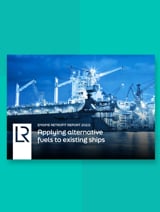We can help you make critical decisions about your ageing assets.
Overview
Port and shore crane structures can rapidly deteriorate because of the environments they're used in. Most of these are environmental factors such as corrosion, physical and chemical attack, and bio-deterioration. General wear, abrasion, fatigue and accidental damage can also accelerate deterioration.
All this can make inspection, maintenance and repairs cost more and limit operating time toward the end of a crane's life.
What we offer
Our independent experts take in-depth measurements and using advanced analysis can give you the right knowledge so you can make decisions regarding the future of your crane assets. Those decision can be made on a sound and rational basis, taking into account your operational, safety and maintenance requirements and costs.
Structural residual life assessment of cranes follows five stages
The two main concerns about end of life are typically corrosion and fatigue. Historical NDT records are collated and used to identify trends and patterns in deterioration. Corrosion can lead to risk of local buckling which may instigate global failure. The historical usage is important to determine the structural fatigue life used to date. This data together with records of major maintenance work, strengthening and replacement forms the foundation of the assessment.
A detailed visual inspection is undertaken to:
- provide input to a structural safety/risk assessment
- assess the quality of welds in critical locations for the fatigue and fracture mechanics calculations;
- identify locations where additional NDT is required;
- identify any critical areas which are difficult to inspect, which will be fed into the final inspection plan.
A global modal survey is undertaken to identify natural frequencies, mode shapes and damping. These parameters characterise the dynamic behaviour and are used to reconcile the fi nite element (FE) model with the measured dynamic performance in Stage Four. We employ state of the art operational modal analysis techniques in combination with videogrammetry and traditional vibration measurements are used to gather these important characteristics.
A program of load testing is undertaken during normal unloading operations and lifting and lowering of the booms, with defl ection measured through videogrammetry and strain measured with traditional gauges. The results are fed into Stage Four and the fatigue life assessment.
It is essential that the FE model is reconciled with measured data from the cranes. For example, it has been our experience that cranes can have one or more legs relatively lightly loaded compared to the other legs or have uneven distribution in loading of the lifting boom stays. Reconciliation with the measured modal parameters gives assurance regarding global stiffness and mass properties together with boundary conditions. The measured strains allow identifi cation and quantifi cation of these and other phenomena if present.
The reconciled FE model combined with the work undertaken during Stages One to Three allow rational estimates of design fatigue life and mean fatigue life. Those joints which have reached the theoretical end of their design fatigue life are examined in further depth with fracture mechanics. The mechanism and time to failure of each joint is estimated through the use of Failure Assessment Diagrams (FADs), which are constructed in accordance with international standards.
The results allow a detailed, rational, risk-based inspection plan to be developed specifying recommended location, type and frequency of inspection. The mean fatigue lives estimated are used to help determine the statistically likely number of locations and frequency of repairs, which provides a basis for costing future maintenance activities and operational downtimes.
Recommendations are made regarding any areas of high concern, which have been highlighted in the safety/risk assessment. Clarity is provided on the structural residual lives of the cranes and the number of fatigue cracks that are likely to occur within the next 15 years based on assumed future loading.
The knowledge developed provides the operator with a sound and rational basis on which to make important decisions regarding the future of the cranes, taking into account operational, safety and maintenance requirements and costs.
Lloyd's Register also assists in electrical and mechanical assessments.
What are the benefits?
Depending on the criticality of a component, failure can cause costly repairs and downtime. Establishing the cause and identifying remedial action allows you to return your ship to a fully operational state as quickly as possible, reducing downtime. Identifying the root cause of failure also enables us to outline how to prevent recurrence, saving you further time and money.
Why choose LR?
Our TID's reputation and expertise is unrivalled in the marine industry, with over 60 years of accumulated knowledge of failures and experience in interpretation using established engineering principles.
With engineers based in Miami, Busan and Southampton, as well as our own metallurgical testing laboratories and a highly skilled, mobile team of engineers we can respond to your urgent needs, wherever you are in the world, and provide timely and expert assistance.
To provide you and your stakeholders assurance that associated hazards and risks have been identified and mitigation incorporated into the design, bringing the risks to an acceptable level, we also have a Risk Team section to complement our TFI service. Our Risk Team has over 20 years of experience in carrying out various types of risk assessments including HAZID, HAZOP, FMEA, RCM, RCA with particular emphasis on LNG related technologies. Our team carries out qualitative and quantitative risk assessments for various projects including LNG plant infrastructure, LNG bunkering facilities, FSRU's, alternative fuel technologies, cyber-enabled technologies and various other marine and offshore related infrastructure.





